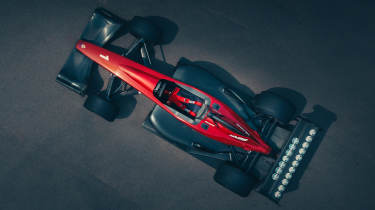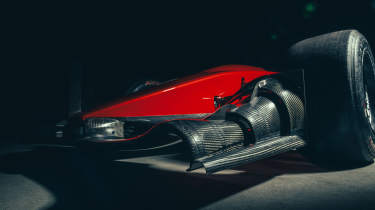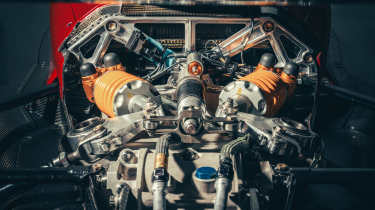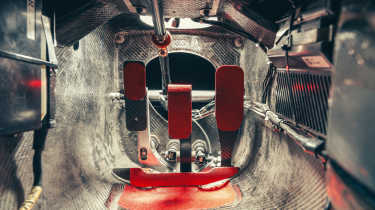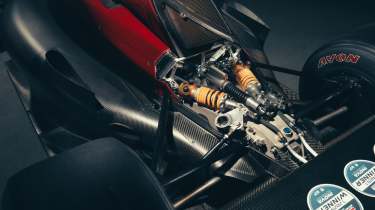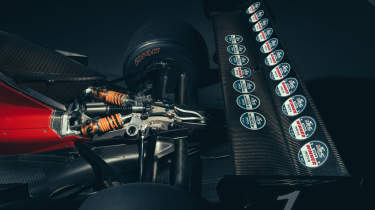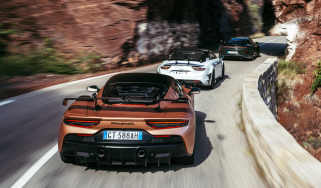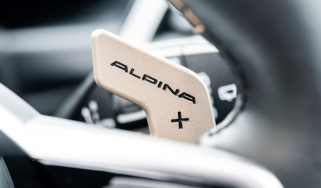The Gould GR58 – if Formula 1 had no rules
The Judd V8‑engined Gould GR59 has claimed five outright British hill climb records, Toby Moody explains why it's untouchable.
In a world of ever-tighter regulation, the comparative lack of regulations when it comes to bespoke-built hill climb cars is one of the sport’s main attractions. That and the utterly staggering speeds of which modern hill climb cars are capable.
David Gould first competed in hill-climbing in the late 1970s in a small single-seater he made at home with brazed tubes and a Mini engine. This was the Terrapin, fun and chuckable, but as with all designer/drivers he wanted more speed, so his next move was straight into the top class of the sport with the Gould 84G, built in 1981. The new machine was born at the height of the titanic battles between the cars with four-cylinder Hart engines, like the 84G, and those with Cosworth DFV V8s. It was a true David (no pun intended) and Goliath contest, but the 84G quickly demonstrated it had the mettle to challenge the then all-conquering Pilbeams.
As is often the case in hill climbing, taking hand-me-downs from F1 generally confers an advantage and, being based not far from Didcot, David was soon doing a deal with Williams’ Patrick Head to acquire a 1981 FW07 gearbox, as the 84G’s previous Hewland FT200 kept breaking. According to Gould it was a done deal to have a free ’box, but Frank Williams found out, meaning that cash had to change hands. Nevertheless, a friendship was made. The 84G later used a Williams FW08 rear wing that had helped Keke Rosberg to the 1982 F1 title. This was the king of cool stuff, but other drivers also had contacts in the F1 paddock and some were even using Goodyear qualifiers, all being fair in love and speed…
Gould drafted in former champion Chris Cramer to share the driving, and together they won the British Hill Climb Championship in 1985, along with the John Bolster Award for Technical Achievement at the prestigious Autosport Awards. Other names engraved on the trophy over the years have included Ross Brawn, Adrian Newey and Gordon Murray, so it immediately put David amongst the giants of motorsport. And then carbon-bodied cars started to appear…
> McLaren-Honda MP4/5B: Anatomy of a V10 F1 champion
Fast-forward to the mid ’90s and with old F3 cars going out of date annually, there were many tubs and chassis around for little or no money, so David and son Sean bought a Ralt and fitted a Ford DFR that was only just out of an F1 pitlane. Lightweight, torquey and tidily packaged, with a tub that didn’t flex, the GR37 was perfect for hill climbing. Within three seasons it was a title-winner, setting Gould Engineering on a path that has since seen their chassis win 23 of the last 26 British Hill Climb Championships with iterations of the GR51, GR55, GR61 and the current GR59.
Body, chassis and aerodynamics
The GR59 was actually born out of an early study for a potential Formula E racer, as Sean Gould explains: ‘We were approached by one of our F1 friends who wanted to make an electric prototype car for a customer in France, a company called Segula Matra. That car used our chassis and then with the help of Mercedes/Brawn they did an aero model. We constructed it off their wind tunnel car.’
It was essentially a pitch for what could’ve been the very first Formula E car. ‘We didn’t know that,’ says Sean, ‘but we were told they wanted to break some F3 lap records first, so it went to Magny Cours and on its third lap it beat the F3 lap record with Alex Prémat [Le Mans, DTM, F3, GP2, etc] driving. But what was also great was he loved the handling of the car, so we knew the geometry was in the ballpark.
> Mercedes CLK DTM: the anatomy of the 2000s V8 touring car
‘It passed all the FIA crash tests too, so for us at Gould Engineering we had all our carbon work verified before they even built that first car. It was quite cool to see Fred Vasseur and Nicholas Todt at the back of the garage as ART were running it that day, but that was as far as it got.’ So with the Formula E car not progressing, it was the perfect opportunity to go hill-climbing with the strong, FIA crash-tested tub.
Importantly, the basis of the GR59 is a modular chassis, which means changes can be implemented to accommodate any engine or gearbox. At the front is the suspension pick-up section; behind that the cockpit, the seat-back and then the engine section. It’s here that Gould Engineering’s main expertise came to the fore, as by the 2010s they had become leaders in composite production for F1 teams who contracted-out work on the high-end prototype parts that are needed on a race-by-race basis.
Indeed, in the case of one F1 team, Sean says the Goulds’ Newbury-based operation has contributed to every single one of its World Championship victories. ‘We’ve had numerous respected F1 people through the door and they have given us very high praise regarding the quality of our work,’ he says. ‘In fact, we actively relish the smaller production runs over the churn of larger runs.’
The final shape of the GR59 is the work of Paul Crooks, ex-Benetton and Ligier, who as senior designer did a fantastic job in making it look cool and not making it ride-height-sensitive across the less than billiard-table-smooth tracks that make up the British Hill Climb scene.
> Penske PC23: the anatomy of a 253mph IndyCar icon
David Gould recalls the GR59’s gestation: ‘We sat down and talked about what we should do next, so we started off with a 1600cc car [British Hill Climb classes for single-seaters are 1100cc, 1600cc, 2000cc and then unlimited capacity] but what was paramount was how we could do this differently, so we built the chassis around the driver but with as small a compartment as possible for the engine – initially a modified Suzuki Hayabusa.’
The smaller engine is installed from underneath, with the top of the carbon tub over-reaching to provide the pick-up points for the rear suspension. As Sean adds: ‘Having the strength of the mounting points for the smaller engine was key because we wanted to avoid tubular mounting points for the block that could very slightly flex under load.’ From there, further experience was gained with Sean performing well in a 1600cc GR59, but he soon wanted to get a big V8 in the back. More on that shortly…
From a safety point of view, the tub is rock-solid and the roll hoop designed and constructed to FIA crash test level, something that is very reassuring to know as occasionally things don’t go to plan – and with no huge run-off areas.
Where the GR59 really upped the game was with its aerodynamics, particularly with the front wing, which is so crucial to the whole balance and speed of the package. ‘About a third of the downforce of the whole car comes from how the wing gets the air into the tunnel under the car,’ David explains. ‘We paid to run a CFD [computational fluid dynamics] program with an aerodynamicist who again was ex-F1. It was imperative we got the right air in the right places.’
It’s a three-plane wing on the car; there was the possibility to go to a five-element wing, but as cool as it would have looked, it would have ramped the price up through tooling. Loïc Bigois was responsible for the front sculpture; formerly of ‘Team Brackley’, he won F1 titles with Brawn and Mercedes and is currently chief aerodynamicist for Scuderia Ferrari.
The front wing of the GR59 is not only elegant but contributes to the sort of lift-to-drag ratio that F1 designers can only dream of due to their rule-book being so much thicker. The downforce is still there at low speed for the hairpins, while top speed is not limited by having a ‘barn door’ on the back.
Engine, gearbox and electronics
As David Gould recalls: ‘It was Wallace Menzies who badgered us the most to get a V8 car to win the title [it clearly worked, with Menzies subsequently winning the British Championship four times in a sister car]. But which engine would it be? F1 units of the ’90s were too old, and a screaming 3-litre V10 or 2.4-litre V8 not practical, so another area of motorsport provided the answer: LMP2 endurance racing and a Judd 4-litre V8.
‘This was a relatively affordable engine compared to the others; they were available at Judd’s and they had quite a few spare parts on the shelf,’ David says. Moreover, Sean wanted an engine that had more than enough power and torque to do whatever he wanted in the future. It meant they could develop the chassis first and generate the grip before turning up the horsepower – as indeed they did. It now produces 686bhp (625bhp in previous years) and 380lb ft of torque, and in a car weighing just 420kg, so the power-to-weight ratio is more than 1600bhp per ton.
‘I didn’t want to take the engine out every winter,’ says David, ‘so as this Judd came from LMP2 endurance racing, it’ll last for a while! We’ve just done six years of hill-climbing and about 1250km but the engine is rated at 3000km for a rebuild, so it’s almost more affordable than a motorbike engine that you have to keep servicing.’
On the transmission front, the gearbox is a transverse layout that was drawn up by Alan Jenkins at Arrows in the mid-’90s but updated over the years by Mike Endean’s X-Trac concern. It’s a six-speeder, controlled by paddles behind the wheel, and arguably the part of the car, coupled with the diff, that takes the biggest stress on a run. When the clutch is dropped, all that torque rattles through the big tyres to a grippy, rubber-laden start-line, so it has to be some feat of engineering.
Shelsley gives a 6 g vertical loading through the bottom of the car when at speed towards the Esses. With tyre-warmers the cornering loads would be even greater, but warmers have been banned in the sport since the mid‑’80s. As Sean says: ‘The tyres have to work from cold, but if there was a way of getting temperature into them for a run, these cars would be ridiculous. Mind-blowing even.’
In fact, back in 2020, former Formula 1 driver John Watson visited Shelsley Walsh and after watching some runs came up to Sean and said: ‘You must be mad to do this speed so quickly from cold.’ But as the Goulds will tell you, it’s all a calculated risk from a driver’s point of view.
Suspension
The car has wishbones at all four corners, fabricated from thin-walled German-made steel that is the strongest and lightest on the market; the same material is used for the roll hoop that connects through to an adapter plate between the engine and the gearbox, which also doubles as a pick-up point for the suspension. All this contributes to make the strength in that area of the car enormous and enough to cope with the very varied surfaces that the championship throws at the cars in the UK. Dampers-wise, it’s Öhlins on the back and Penske on the front – not standard, of course, but ‘very special’ is all Sean will say.
Driving it
Hill climb cars use 100 per cent of their lightweight construction 100 per cent of the time but don’t use 100 per cent of their power 100 per cent of the time, leaving the staggering torque as the key to record-breaking for Sean Gould and Matthew Ryder when pedalling this monstrous 4-litre V8. It’s that mid-range that has helped them get the times and break the outright records at Shelsley Walsh, Wiscombe, Doune, Loton and Prescott between them over the past four seasons.
‘We’ve long-geared it to save ourselves gearchanges – and the dog-rings in the gearbox – plus as a driver you don’t want to be pinging through the paddles like a PlayStation,’ says Sean.
‘It’s insane when you’re in it for the first time. The acceleration is nothing like you’ve ever felt before,’ he continues. He says that even drivers who have come from a turbocharged 5-litre V8 Sauber Le Mans car have had their head frazzled by the GR59. From standstill, 100mph is reached in under four seconds at Shelsley, while the slightly downhill start at Gurston Down means the car takes a mere seven seconds to get to 150mph, all pretty quick considering it will actually go around corners too. ‘We took it Turweston airfield a couple of years ago and I got it into sixth gear about half way along the runway, so I was just sitting there at 195mph on the rev-limiter even with the full hill-climb-spec aero on it.’
Sean has watched all sorts of drivers over the years but after seeing Matthew Ryder driving a 1000cc Empire single-seater and then a 1600cc Empire Wraith, they had a chat. Matthew’s grandfather, Ken Ayers, was a British Sprint Champion and the whole family ‘got’ what was needed to have a crack at the title. That worked fantastically in 2024 with Matthew taking the title with 14 wins out of 27 rounds, including utterly demolishing the Wiscombe and Prescott records, the former by a jaw-dropping 1.14 seconds.
‘It’s an awesome machine,’ he says. ‘Having watched these cars go up the hills since my childhood, you always think they look quick, but when you get in one it’s so much more than you ever believed it would be. It will wheelspin at any speed in any gear, even with the modern control systems, so you have to get used to that. The flip-side is that if you don’t hoof it, it retards too much and the package doesn’t work.’
The EuroMillions question
With an unlimited budget there are areas where Sean says the car could be improved through a bespoke chassis for each driver/customer. And, incredibly, he also says that there is potential to take 30kg off the car to get it under 400kg and still be safe. It’s a quite staggering stat, but how? ‘There are massive differences in performance regarding carbonfibre’s compressive and tensile strength, plus different core materials and resin films can all be used for the diet.’
Carbonfibre costs start to skyrocket when the quality goes up. It’s relatively easy to make a material that does the job, but through their F1 work the Goulds know the hard data about carbonfibre, so they also know the opportunity is there to put the really expensive stuff in that’s half the weight but ten times the price.
The Shelsley Walsh record
Winning the Monaco GP; scoring a century at Lords or hitting the winning round at the Masters – they’re all ultimates in the world of sport. For hill climbing it’s the outright record at Shelsley Walsh in Worcestershire, the oldest motorsport venue in the world, still held on the original course that dates back to 1905.
Martin Groves had set a stellar time in 2008 of 22.58 seconds for the ultra-fast 1000-yard course, but it was a tyre war between Avon and Pirelli in the early 2020s that really set the hill alight, culminating in August 2021 with a thrilling Top 12 Run Off. Wallace Menzies steamed up, beating the then 13-year-old record with 22.55 seconds. Next up, Sean Gould in the GR59…
‘I wasn’t far off being flat through Kennel and Crossing and that’s really where I did the time, and the more I look back at it I really don’t think I could do Crossing [a blind long left with a slightly adverse camber] any quicker than I did. On the logger it was 156mph on the Bottom Ess approach.’ The record was his with 22.37 seconds, Alex Summers following him up with an equally breathtaking 22.52 in the Cosworth XD-powered DJ Firestorm. The record had fallen three times in three runs, but it was Gould who was crowned King of Shelsley.



